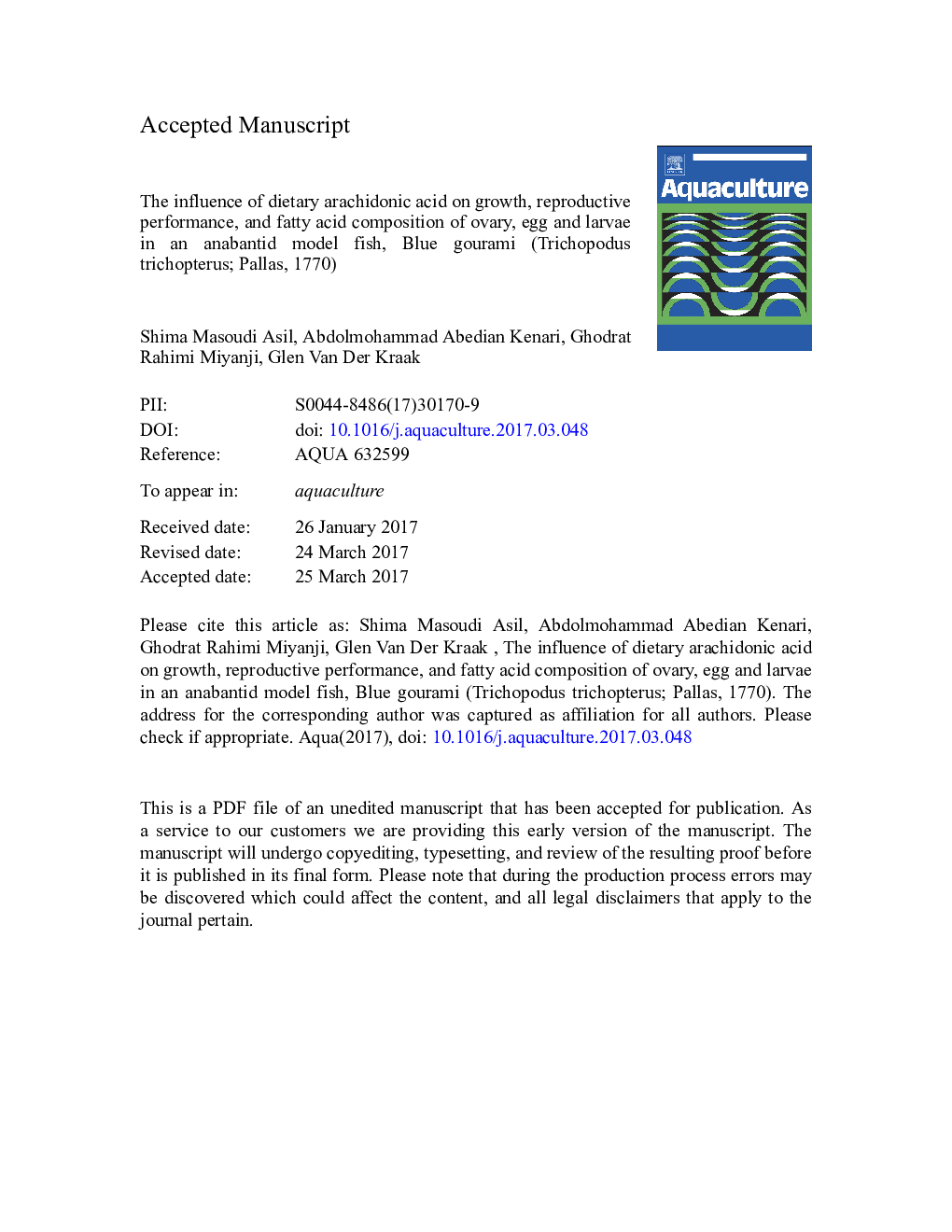| Article ID | Journal | Published Year | Pages | File Type |
|---|---|---|---|---|
| 5539407 | Aquaculture | 2017 | 47 Pages |
Abstract
This study investigates the influence of arachidonic acid (ARA) on growth, reproductive performance, and fatty acid compositions of ovary, egg and 3-DPH (days post hatching) larvae of Trichopodus trichopterus broodstock. A 150-day feeding experiment was performed comparing the effects of five ARA-supplemented diets containing 0 (control), 0.5, 1, 1.5 and 2% ARA (of total fatty acids) (TFA). Growth parameters including final weight, weight gain and specific growth rate (SGR) did not differ between different groups (P > 0.05). Feed conversion ratio (FCR) was significantly lower in control group compared to 0.5 and 1.5% ARA groups (P < 0.05). Contrary to growth indices, all reproductive traits were significantly affected by ARA contents in diets. Absolute and relative fecundities increased in relation to the ARA content (P < 0.05). The maximum absolute and relative fecundities (13.3 and 974.3 Ã 103, respectively) were recorded in 2% ARA treatment group (P < 0.05). Mean oocyte diameter reached the greatest size (861.66 μm) in 1% ARA and was significantly different than other treatments (P < 0.05). The yolk sac diameter was enhanced linearly by increasing dietary ARA (P < 0.05). Results showed striking effects of dietary ARA on its accumulation in ovaries, eggs and larva. Æ© n â 6 series fatty acid (44.9%) and its constituent (18:2n â 6) (40.85%) reached the highest contents in 0.5% ARA in ovaries (P < 0.05). A similar trend was seen in fertilized eggs and 3-DPH larvae in that the highest amounts of 18:2-6 and Σ n â 6 were found in the 0.5% ARA group (P < 0.05). A second order polynomial regression was employed for estimating ARA/EPA (eicosapentaenoic acid) ratios and showed that the respective ratio enhanced linearly in the ovary and fertilized egg. Correspondingly, ARA/DHA (docosahexaenoic acid) ratio in ovary, fertilized egg and larvae reflected those of the experimental diets. Their fatty acid profiles reflect the diet composition well, ovary (R2 = 0.87), fertilized egg (R2 = 0.91) and 3DPH larvae (R2 = 0.82) and the ARA/DHA ratios were linearly improved by increasing dietary ARA (P < 0.05). Overall, the results of this study revealed the necessity of ARA inclusion in T. trichopterus broodstock diets. This conclusion challenges the generally accepted hypothesis that freshwater fish meet their highly unsaturated fatty acids (HUFA) requirements by elongation and desaturation their precursors. These findings showed that T. trichopterus broodstock, as a model of asynchronous multi-batch spawning fish, needs to receive at least 1% ARA in their maturation diet to improve reproductive performance. The best efficiency was achieved in 2% ARA, based on fecundity, yolk sac diameter and hatching rate.
Keywords
EFAFBWSGRFCRTFALNAHSIFFADMRTIBWHUFABHTLC-PUFADPHBF3GSIEPAsum of saturated fatty acidsOne-way ANOVAArachidonic acidEicosapentaenoic aciddocosahexaenoic acidLinoleic acidalpha linolenic acidEssential fatty acidFree fatty acidsHighly unsaturated fatty acidsLong chain polyunsaturated fatty acidsWeight gainone-way analysis of varianceBoron trifluoridestandard error of the meanARADHAdays post hatchingHepatosomatic indexgonadosomatic indexCondition factorfatty acid methyl estersFAME یا fatty acid methyl esters SEMspecific growth ratefeed conversion ratiobutylated hydroxytolueneinitial body weightfinal body weightGas chromatographyTotal fatty acids
Related Topics
Life Sciences
Agricultural and Biological Sciences
Aquatic Science
Authors
Shima Masoudi Asil, Abdolmohammad Abedian Kenari, Ghodrat Rahimi Miyanji, Glen Van Der Kraak,
